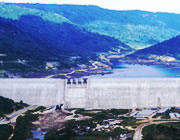Development of water sources for cultivation or irrigation is important and beneficial for the majority of the country’s population in that it enables them to produce crops all the year round. At present, most of the cultivated land in every region of the country is outside irrigated areas. They rely mainly on rainwater and water from natural sources. As a result, crop production has to suffer from irregular water supply and fluctuations of rainfall which cannot serve the needs of the crops. His Majesty the King attaches priority to the projects concerning the development of water sources. His Majesty recognizes the importance of the value of water and considers it to be “life” as appeared in his following speech delivered at Chitralada Villa on March 17, 1986:
…The importance is we must have water to drink, use and cultivate because life is here. If there is water, we can survive. If there is no electricity, we also can survive. But if there is electricity but no water, we cannot survive…”
The development of water sources under His Majesty’s initiatives is based on the following principles and methods:
1) The development of water sources must be appropriate to the local topographical conditions.
2) The projects for the development of water sources must be appropriate to the conditions of the natural source of water in the locality.
3) The development of water sources must be appropriate to the socio-economic conditions of the local areas. It must avoid causing trouble to one group of people while contributing benefits to another group of people. Regarding this work, His Majesty insists that the problem of land allocation should be solved in such ways that it will benefit all parties. Those who lose land should be properly assisted so as to encourage them to positively accept the decision of the government and allow the government to make use of the land without having to purchase additional land. He also wishes that the local people cooperate with the officials and with one another in the community in looking after and maintaining the provided constructions.
The projects on the development of water sources can be divided into five categories as follows:
1) for cultivation and consumption such as reservoirs and dykes
2) for preserving water sources and streams
3) for electricity generation
4) for water drainage from low lying areas
5) for relief of flooding
|

|
However, most of the projects on the development of water sources are targeted at agriculture although they may have different minor objectives. Examples include the Pa Sak Jolasid Dam Project, the Royal-initiated Pak Phanang Basin Area Development Project, the Kaem Ling Project, etc. |
The benefits from the projects on development of water sources are:
1. bringing maximum water supply to the cultivated areas enabling the crop cultivation to take place twice a year during the rainy season and the dry season. Farmers are able to grow a second crop leading to increase of production and their income.
2. converting flooded areas into productive land where areas for cultivation are allocated to farmers to produce crops. In a way, this effectively stops the people from encroaching and destroying forested areas and helps preserve the existing forests. This type of project exists along the edge of peat soil areas such as the project to drain water from the basins according to His Majesty’s initiatives.
3. providing fish supply for the farmers, that is, when a reservoir is constructed, fish fry will be released to be food or source of supplementary income for the farmers in the nearby villages.
4. providing clean water supply for the people for consumption throughout the year as well as for raising animals.
5. helping to relieve flooding in major cities and communities; for example, Bangkok Metropolis and its environs, Hat Yai District of Songkhla Province and Nong Yai District of Chumphon Province. This helps reduce damage to the country’s economy both in relation to the private and public sectors.
6. generating hydro-electricity for household uses for the people living in remote underdeveloped areas.
7. providing moisture in the soil, allowing the forests to stay green throughout the year and establishing ‘wet fire break’ which forms a protective strip against forest fires all over the watershed areas. For this purpose, check dams, together with water distribution system, are constructed at different levels along the streams to spread moisture to the areas on the banks of the streams.
It can be said that His Majesty takes into consideration every aspect and each step of the process concerning water sources development as Mr. Pramote Maiklad, then Inspector-General of the Ministry of Agriculture and Cooperatives, was quoted in the weekly newspaper Prachachart Turakij 5-10 October 1995:
“…His Majesty will seek to find more water supply when there is water shortage; to reduce water when there is flooding and to find treatment methods when the water is polluted. His Majesty is aware of the problems in details… ”
Examples of the Royal Development Projects on Water Sources Development
The Flood Management in Bangkok and Metropolitan Areas Project (the Kaem Ling Project)
“…When I was five years old, we had monkeys and we gave them bananas. They would munch, munch, munch, and then kept the food in their monkey cheeks. It follows that this “Monkey Cheek Project” actually originated way back when I was five years old. Five years old, that is, 63 years ago. The monkeys of that time, the ancient monkeys, already had monkey cheeks. They munched and stored their food in their cheeks. When flood waters come down, and we have no “Monkey Cheek Project”, that flood would inundate all over the place, the same way it did this year, all over the central plains. We have to make a “Monkey Cheek” as a retention area to keep that water…”
His Majesty’s royal speech granted on December 4, 1995
|

|
The Kaem Ling Project (or Monkey Cheek Project) is the Royal Development Project that deals with solving flooding problems in Bangkok and metropolitan areas by excavating the canals along the coastal areas both in the west and the east of the Chao Phraya River to serve as big storage reservoirs or Kaem Ling (Monkey Cheek) and draining floodwaters away by natural means such as gravity flow or tidal flow. At present, the Kaem Ling Project has extended to cover other areas namely the Nong Yai Area Development Project (Nong Yai-Natural Kaem Ling), Chumphon Province and the Project to Relieve Food Problems in the Khlong U Ta Phao Basin, Hat Yai, Songkhla Province. |
Pa Sak Jolasid Dam
“…Originally, the Pa Sak dam was planned for a capacity of 1,350 million cubic metres. But after some modifications, it was left with about 750 million. Considering the figures given here, the Pa Sak reservoir will undoubtedly be able to cope with the needs of water consumption; there will be no water shortage.”

The Pa Sak Jolasid Dam was constructed to store water for agriculture in the dry season and to prevent and reduce the flooding problems in the rainy season in the area of the Pa Sak river basin and in the lower area of the Chao Phraya river basin. Besides, the dam is capable of solving the wastewater problems in Bangkok and big cities in the Central Region. Moreover, the dam serves as a breeding site for fish as well as a tourist site for visitors.
The Royal-initiated Tha Dan Canal Dam Project, Nakhon Nayok Province

“…This project involves the construction of two dams. One of them is on the Pa Sak River; the other on the Nakhon Nayok River. These two together will provide adequate water supply for the water demands of Bangkok and neighboring areas in the central plains of this country.”
“…This project is feasible, though costly. But if we implement it at once, in five to six years, we will be safe. If we don’t do it now, in five or six years, the cost will rise two or three times. In the end, we will have to postpone it further; and when we postpone it further, it will never be done. We will surely suffer a lack of water. The country will become a desert. And we have nowhere else to go…”
The Royal-initiated Tha Dan Canal Dam Project was established to reduce the damage from flooding within the plain area of Nakhon Nayok Province that regularly occurs. In addition, the project will supply water for agriculture and adequate daily consumption, and importantly, help solve the problem of acidic soil that is a crucial obstacle for the people to do cultivation.